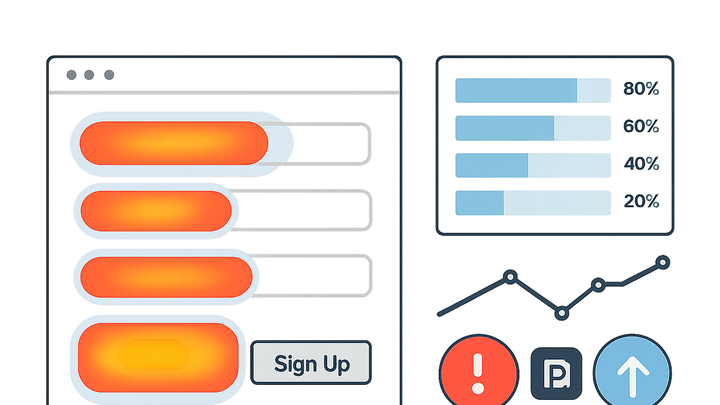Published on 2025-06-29T20:02:23Z
What is Form Analytics? Benefits, Tools, and Best Practices
Form Analytics is a specialized branch of web analytics that focuses on user interaction with online forms. It captures detailed data on how individuals engage with each form field, including time spent, errors encountered, and points of abandonment. By analyzing these interactions, teams can identify friction points, streamline form design, and boost conversion rates. In the realms of CRO, UX, and SEO, form analytics uncovers insights that standard analytics tools often miss. For instance, pinpointing the field that causes the most errors can guide validation improvements, while tracking where users drop off informs layout adjustments. Platforms like PreVue.me combine in-depth analytics with expert critiques to help you optimize forms for maximum lead generation and accessibility compliance.
Form analytics
Form analytics measures how users interact with web forms, tracking metrics like drop-off rate and errors to optimize conversions and user experience.
Why Form Analytics Matters
Form analytics provides insights into how users interact with online forms, highlighting areas where they struggle or abandon the process. By tracking both form-level and field-level metrics, teams can prioritize improvements that drive higher conversion rates, better user satisfaction, and stronger accessibility compliance.
-
Optimizing conversion rates
Identifies exactly where users abandon the form so you can address those fields and reduce friction.
- Identifying bottlenecks:
Pinpoints fields with high abandonment so you know where to focus your optimization efforts.
- Reducing friction:
Simplifies or reorders problematic fields based on real user behavior to streamline completion.
- Identifying bottlenecks:
-
Enhancing user experience
Reveals how users engage with each input, uncovering confusing or underutilized fields that need redesign.
- Field interaction patterns:
Tracks clicks, focus time, and hover events to understand user attention and confusion.
- Error tracking:
Logs validation errors and their frequency so you can improve form guidance and messaging.
- Field interaction patterns:
-
Supporting accessibility compliance
Monitors form interactions for users with disabilities to ensure your forms meet accessibility standards.
- Keyboard navigation data:
Tracks how keyboard-only users move through the form to identify navigation barriers.
- Screen reader compatibility:
Tests form labels and ARIA attributes to ensure proper support for assistive technologies.
- Keyboard navigation data:
Key Metrics in Form Analytics
Form analytics revolves around several critical metrics that together paint a detailed picture of form performance. Understanding these metrics helps you prioritize fixes and measure the impact of your optimizations.
-
Field interaction rate
The percentage of users who engage with a specific field, indicating its clarity and relevance.
-
Time to completion
Average time users take to complete the form, revealing complexity or usability issues.
-
Error rate
Frequency of validation errors per field, helping identify problematic inputs or unclear instructions.
-
Drop-off rate
The rate at which users abandon the form at each field or step, highlighting major friction points.
-
Conversion rate
The overall percentage of form submissions out of total form views, serving as the ultimate success metric.
Implementing Form Analytics with PreVue.me
PreVue.me is a SaaS platform that provides actionable critiques and analytics for optimizing forms across CRO, UX, SEO, and accessibility. It delivers in-depth reports, field-level insights, and prioritized recommendations to maximize lead generation.
-
Setting up prevue.me
Add the PreVue.me tracking snippet to your site and connect your form identifiers to begin data collection.
- Installing tracking code:
Copy and paste the PreVue.me JavaScript snippet into your site’s header for universal tracking.
- Configuring form ids:
Assign unique IDs to each form so PreVue.me can segment data accurately.
- Installing tracking code:
-
Analyzing reports
Use PreVue.me’s dashboard to monitor drop-off hotspots, error trends, and field engagement patterns.
-
Applying actionable critiques
Follow prioritized recommendations from PreVue.me to refine field labels, adjust form layout, and enhance user guidance.
